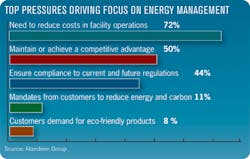The Benefits of Energy Intelligence
Traditionally, energy use has simply been a growing cost of doing business. However, with the increasing prices of energy, manufacturing executives can no longer ignore the impact energy reductions can have on an organization’s bottom line. In fact, the U.S. Energy Information Administration estimates that the industrial sector consumes half of the world’s total delivered energy, making it the largest end-user sector. Indeed, sustainability has evolved from a social expectation to an economic imperative.
In fact, Aberdeen’s recent research, “Energy Intelligence: Driving Optimization with Visibility,” found that cost reduction is still the top pressure driving companies to focus on energy, followed by the need to achieve a competitive advantage. Aberdeen Group’s research for the past three years has consistently shown cost as the top driver for industrial organizations. Interestingly, compared to last year’s study, “Carbon and Energy Management in Manufacturing Operations” where the pressure of cost came out to be 68 percent, this year’s results revealed a slightly higher focus on cost. This is especially critical in an energy-intensive plant where energy cost is often upwards of 25 percent of the total operational costs. The ability to cut even a small percentage of total energy consumption can result in significant savings.
What exactly are leading companies doing differently in order to tackle these top line pressures? Aberdeen research uncovered that best-in-class companies have truly taken a holistic approach toward energy management by establishing the right strategy and effectively executing that strategy through changes in business process, organizational structure, knowledge and performance management.
In particular, best-in-class companies have successfully established an energy-conscious culture by creating cross-functional teams and having executive sponsorship for the energy management program. They also have established a framework of best practices for integrating energy efficiency into management practices.
Coupled with these business processes, best-in-class companies have invested in key technologies, particularly in energy management / intelligence systems.
Improve company performance
An energy management / intelligence system includes key capabilities such as: automated data collection, energy dashboards, alerts and event management, and energy analytics. Automated data collection forms the basis of any energy intelligence deployment, and is the foundation of real-time decision making. Once automated data collection is formed, the final three components, when jointly adopted, allow organizations to put real-time events into context and make optimal decisions based on historical trends.
The data provide executives with ability to make the connections between day-to-day tactical operations and strategic business goals. And it enables leaders to extract value from the huge amount of energy data collected and deliver that data in front of the appropriate employees for effective decision making. This is the true benefit of energy management / intelligence.
Through a combination of business capabilities and technologies, best-in-class companies are able to create an energy-aware culture and truly transform their organization into best-in-class status. They do this not only by being more energy efficient (surpassing their energy goals by 22 percent) but also by realizing higher operational efficiency (with a 89 percent overall equipment effectiveness (OEE) rate) and surpassing operating margin goals by 21 percent.
Indeed, the benefits of implementing an energy management program are impressive. This was particularly the case with a certain director of a multi-billion-euro materials company. Commenting about his company’s energy management system, he stated, “Since implementing our energy management system, we have been able to gain real-time visibility into our energy consumption and therefore have been able to improve our energy efficiency by roughly 10 percent. Due to the nature of our business, this 10 percent translates to double-digit millions of euros in savings.”
Nuris Ismail, [email protected], is senior research associate for manufacturing and Matthew Littlefield, [email protected], is senior research analyst for manufacturing at Aberdeen Group in Boston.

